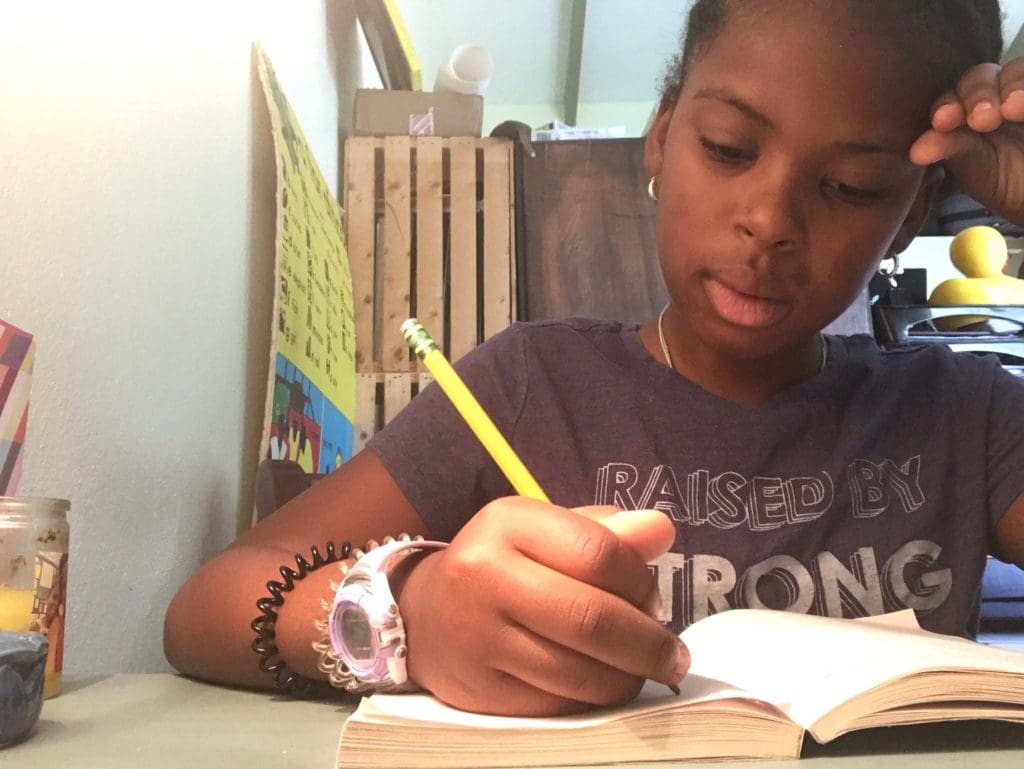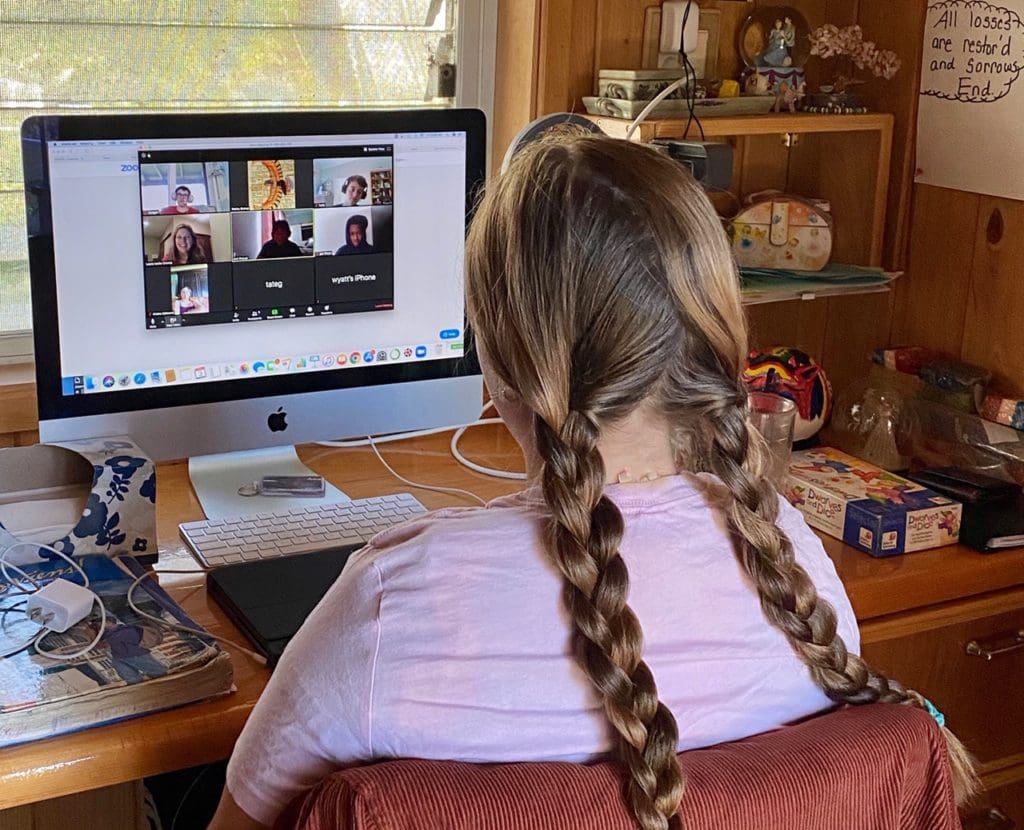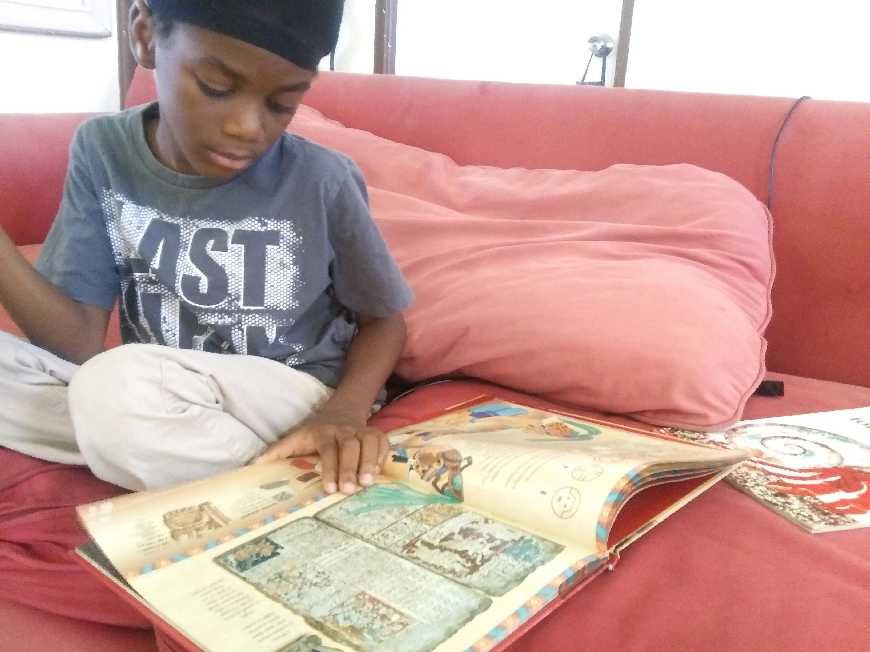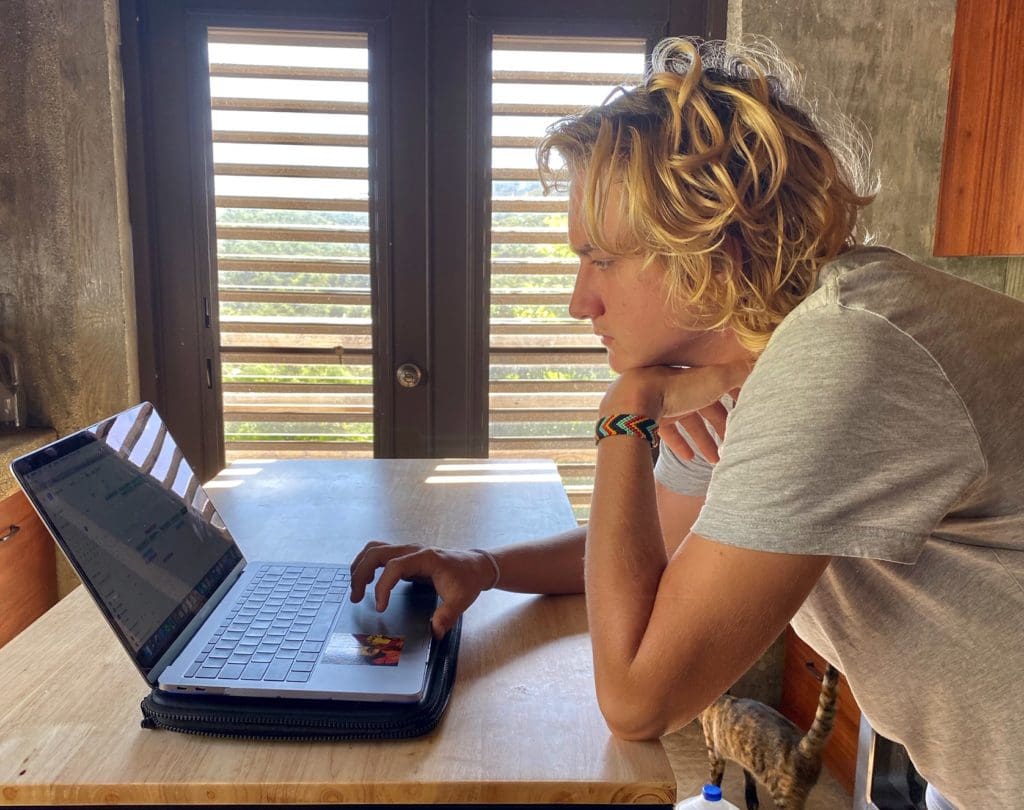
Submitted photo
This is the second in a two part series on long-distance learning programs and strategies for V.I. students during the COVID-19 pandemic. This part focuses on St. Croix. The first part, which focused on St. Thomas, can be read here.
Now at the end of the second week of online education, teachers and students in 14 public, 10 religious, and four private schools on St. Croix are adjusting to their new way of life. Some are going with the flow, while others are feeling thrust against the current.
Educators say with hundreds of users online at the same time, some students are not progressing as quickly as the more tech savvy ones, who are breezing right through their assignments.
It takes time to create a new way of life. It takes patience and discipline, and just the right amount of independence. Those are virtues that don’t always come easy when a smartphone has been used for video games and everything fun in the recent past.
Still, the majority of students who are now using their smartphones to further their education say it’s a fun experience. Sometimes it’s the solitude that needs adjusting to, but they’re seeing it begin to happen.
“I like it,” said St. Croix Educational Complex speech and drama teacher Sayeeda Carter. “As an overextended person, there’s even some quality time for a sense of family.” Before the remote learning schedule, Carter did not experience much time together with her two girls in her day-to-day parenting.
Carter uses a good number of writing components with the EDMODO platform. Speech students are required to analyze speeches, and they learn vocabulary by watching two TED talks per week, one teacher-assigned and one chosen by the students.
Drama classes are a little harder online, she said, “but we are working at it.” The students upload a video of themselves in a dramatic setting.
“We are committed, dedicated, and focused and still on it – embracing this new way of life,” Carter said. “It’s a difficult process for those students who are not doing well academically. I will have to make changes for certain students based on the responses I’m getting. I will create a time frame where I see them physically sign in three times a week. Some students are just not ready for this level of independence.”

Carter said she is nervous but hopeful about the struggling students and wonders what is being done for their mental health. “There must be no TV free-for-all in the home. I’m hoping parents are limiting screen time,” she said. “It’s a time for resetting ourselves globally. We could get some good out of this.”
Regina Keels, Carter’s colleague at SCEC, spoke with the Source about her Grade 10 and 11 English classes after the first three days of online teaching. With two weeks behind them, most of her students are accepting the programs, the use of the devices and the internet. Sometimes responses are slow, so Keels gives students another half a day to complete their assignments.
Parents are very receptive, Keels said. They are understanding and thankful, she added.
Keels previously home-schooled her son, who is in Grade 10. He continues with the same program and does very well, she said.
Zahra O’Reilly-Bates teaches an accelerated class of fourth, fifth and sixth-graders at the Ricardo Richards Elementary School. A paraprofessional teacher assists O’Reilly-Bates with her 13 students.
O’Reilly-Bates attended a Webinar that allowed her to “play around” with the Microsoft TEAMS platform, which she likes. With the platform she developed a class notebook for each student. TEAMS enables her to add other platforms. Students can communicate with chat groups, allowing them to interact with each other.
Students are still getting comfortable with the platform, yet they can help each other and can manipulate the platform and teach each other how to use it on different levels, O’Reilly-Bates said. She added they are innovative when using the smartphones and the computers.

O’Reilly-Bates saw that four of her students were missing from lessons. Three of them have siblings at home, which created a problem with their participation. There may not be multiple devices for use or sometimes the devices are not available in the home until parents return from work. Her solution is to set up a different meeting time for students with those particular issues. They can meet online via email or phone everyday for an hour to an hour and a half.
The plan is to poll again to collaborate on a time conducive to all.
When asked if they miss attending their regular school, some students say they do because now they have more work – school work and chores at home – but the majority answered, “not at all.”
Zuma Nisbett is a 10-year-old, fifth-grade student at Ricardo Richards. She and her classmates were sent home with packets of learning assignments – science, social studies, reading, math, and English language arts – and instructions to meet on the platform ZOOM. “We meet Monday, Wednesday, and Friday at 10:30 for about 30-45 minutes,” she said. “Math and reading have not been scheduled yet. There are multiple students I get to see with my teacher. I like the online learning.”
“We do four hours of work from the packet everyday,” Nisbett said. “My three-year-old sister attends St. Croix Montessori School. They send projects for her to do, and sometimes we do our work at the same time.”
Nisbett prefers the remote learning to her former school environment. She feels safe at home and her mom does art, baking, and gardening projects with her and her sister, she said. Nisbett’s mom is an educator, who enjoys teaching from home.
Jessica Parker and Raydiance Cherubin are teachers at Arthur Richards School. Parker teaches sevenh and eighth-grade art, while her colleague Cherubin teaches three classes of grade seven math.
Parker talked to the Source about the resiliency of the students at Arthur Richards. The school, like others, was closed as a result of damages from Hurricane Maria. When other schools returned, the Arthur Richards school had problems. When they finally returned, they were transferred to The Eulalia Rivera school building. Now they are confined to remote learning. And the students are doing amazingly well, Parker said.
Parker uses the platform EDMODO to assign students their Monday to Sunday log. They are asked to recognize what they did successfully in their household – like helping parents cook or garden, something to give them a sense of normalcy. They’re also asked to write something they’ve seen or read in U.S. Virgin Islands current events or elsewhere in the world.
Parker posts every Friday and the post is available for parents and students to see each day. Parker invited this Source writer to log in to EDMODO as a student to get a look at the assignments. This writer checked in and clicked on the assignment and went on to the next day without doing the work. By the third day a bright red sign appeared at the top of the page: “You Are Late,” it read. Students cannot go further on without doing the work.
“I am still reaching out to those parents I haven’t heard from,” Parker said. Some phones are not working. Ninety-five percent of students are doing well. “I am still tracking down the other five percent,” she said. Some students stayed home the days before the closure and didn’t get packets.
“It’s a little exhausting,” Parker said. Some students are not getting the use of devices until later when their parents come home. “I’m available all the time and it can be overwhelming participating on the computer and the phone,” she added.
Parker received a text message from a dad who reached out to her because his son was not doing the assignments. Parker got him back on track and the student has begun to do the work.
Creating a basketball jersey is one of the art assignments students say they like. They are learning complementary colors using YouTube and text instructions. Past students’ artwork is shown as examples.
When students draw an assignment, they must take a picture of it, upload and send to Parker on EDMODO.
A new Arthur Richards School is planned for the future, possibly on the site of the Charles H. Emanuel School. Parker’s latest art assignment is for students to design the layout of the new school. She suggested they give the design their biggest dreams. Some students are designing a swimming pool, others want bike racks and lockers or green space for agriculture. Layouts include a music and art space with room for steel pans. There will be a student lounge along with a reward system for outstanding students to go and hang out during lunch period.
Parker is giving remote learning a second look and her students are loving it, she said.
Parker said, “Give us hurricanes. Say there’s no supplies. Give us remote learning. We just make it work. That’s what we do at Arthur Richards.”
Ten-year-old Isis attends the fourth grade at Ricardo Richards Elementary School. According to her mom, she completed her assignments in math, science, reading and writing, turned in one assignment, but her teacher has not been available to receive the remainder of her work. Her mom will contact the teacher, she said.
Her eight-year-old brother, Wadi, is in second grade at Ricardo Richards and hasn’t heard from his teacher, although she sends messages to parents through WhatsApp. There will be a phone call to his teacher, his mom said.

Isis, King, and their brothers Wadi and Shree say they like the remote learning. They also like having mom at home to engage them in special projects like gardening.
Mom is not impressed with the public school learning and will be looking for an alternative the next school year, she said.
Cherubin uses ZOOM, google classroom and EDMODO to teach her students 7th-grade math. She did a live session to acquaint them with the learning platforms. She posts assignments, videos, and fun activities. Everyone can see and communicate.
There’s “Moving Mondays” to keep students from becoming constricted. A Wellness check in: “I’m Ok.” “I’m good.” Meanwhile “Free Up Fridays” allow students to take a picture and post.
Cherubin’s three-week learning packet mapped out daily assignments careful not to overwhelm.
Facebook is a helpful resource, Cherubin said. “We have a main group page for math. There’s a different theme every day – math, English, social studies. We post things that are encouraging. We’re working on a step-by-step drawing, a tie-dye for everybody to work on, and then take pictures and share photos with other students.”
Cherubin provides home school sessions for her niece and nephew, which helps when her siblings and their spouses go to work during the remote learning period. The children are four and six years of age. “It’s a lot of work and very tricky keeping in all in place,” Cherubin said.
DeVante is a 15 year-old, Grade 10 student at the SCEC. “It’s going well for me. I’m turning in work with grades of 90 and 100,” he said. DeVante likes this kind of learning, because he can look something up and have a better understanding, he said.
“I can break down a problem in geometry and build it back up. YouTube is great for explaining methods and I do like working remotely,” he said.
Asked if he misses his friends, DeVante said he does miss them. He likes playing basketball and just joking around with his neighborhood friends. He does understand that the self-isolation is a precaution for remaining healthy, he said.
DeVante spoke about the 17year-old who was found dead on St, Croix recently. It saddened him especially because he knew him. “He was a talented rapper and I always encouraged him to stick with it. I knew he could be successful,” DeVante said.
Good Hope Country Day School students Lucia and Necha Bishop were on Spring Break during the first week of the school closures. They’re one week into the remote learning and they are both doing well, they said.
Lucia is 17 years of age and in Grade 11. There are a couple of scheduling overlaps with his teachers, but they are figuring it out. “It’s pretty nice to work from home. It’s pretty cool the way the teacher pre-records a video and does a voice-over that we can watch and watch again,” Lucia said.
“We had a chemistry test yesterday and we signed an honor code not to cheat. It was a trust for.the students,” he said.
Lucia’s subjects are Spanish 3, American literature, U.S. history, Algebra 2, Chemistry, photography and art. When he does his online assignments, he prints them out, scans them as a PDF and sends to his teachers.
Lucia is a sailor and although he misses the sport, he will take part in a virtual regatta this weekend. No chance of him getting wet.
Necha is a ninth-grader. The 15-year-old and her classmates are doing well in their first full week of online learning, she said. Monday, Wednesday, and Friday are devoted to core subjects – biology, language arts, and math. Her French class is normally four days, but online it’s twice a week.
“It’s a new experience and I like the online work. It’s going pretty smoothly. Some days we meet the teacher and class with ZOOM and GoogleMeet,” she said.
Although nothing definite has been talked about, Necha is comfortable if the online learning goes through the end of the school year, she said.
Some students and teachers have noticed there is a lag in a platform periodically. They attribute it to the multiple users on at the same time.
One parent expressed concern when she experienced the lag. She thought she was being closed down because she was late with her monthly internet payment. She was able to get back on, but she is still concerned.
Anthony McDonald attends St. Croix Montessori School. He is seven-years-old and in the elementary class with 18 classmates. McDonald loves his Montessori school and he especially loves this new way of learning, he said. “I like mom being home.”
The Montessori elementary curriculum teaches McDonald about Ancient Greece, math, reading and language arts. He likes the platform ZOOM where he can see his teacher and his classmates.
McDonald is given a 30-minute reading requirement everyday and he likes it. He may choose whatever he wants to read. ReadWorks is a link that he can access as his own account with a password. That sounds like some mighty good Montessori learning tools for seven-year-old McDonald.





